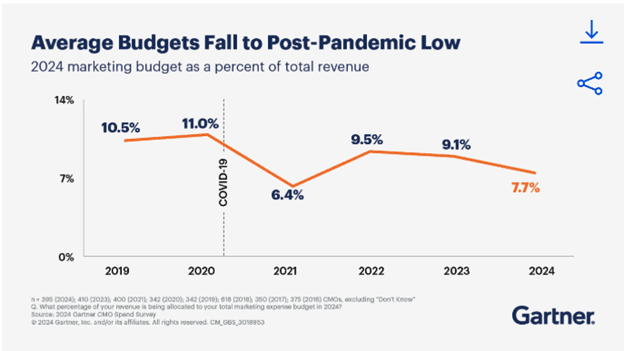By Maria Geokezas, Chief Operating Officer at Heinz Marketing
Looking Back: The Growth-at-All-Costs Era
Just two years ago, the B2B market was fueled by a “growth at all costs” mentality. Venture capital was abundant, interest rates were low, and businesses were under immense pressure to scale aggressively. Companies prioritized market share over profitability, pouring resources into customer acquisition without a clear path to sustainable returns.
This was reflected in spending patterns. According to Gartner, global B2B marketing budgets hit 9.5% of total company revenue in 2022, up from 6.4% in 2021. Metrics like total leads, top-line revenue growth, and customer acquisition numbers took center stage—often at the expense of efficiency and profitability.
However, cracks in this model started to appear. As economic uncertainty grew and funding tightened, businesses realized that unchecked spending without a clear path to profitability was unsustainable.
The Shift to Efficient Growth: Market Signals and Key Indicators
The past two years have seen a significant pivot toward efficiency and profitability. Several key market signals highlight this shift:
- Investor Sentiment Shift: With rising interest rates and economic volatility, investors have turned their focus from hypergrowth to profitability. Companies seeking funding are now expected to demonstrate strong gross margins and predictable revenue streams.
- Budget Cuts and Restructuring: Gartner’s 2023 CMO Spend Survey showed that marketing budgets have dropped to 8.2% of company revenue, signaling a more cautious approach to spending. Marketing teams are being asked to do more with less.
- Changes in Hiring and Tech Stacks: Many B2B companies have reduced headcount, particularly in sales and marketing. Additionally, tech stacks are being optimized, with firms scrutinizing tool redundancy and shifting toward platforms that drive measurable ROI.
- Renewed Focus on Customer Retention: Retention rates and customer lifetime value (LTV) have become more critical than new customer acquisition. Businesses are investing in customer success, expansion strategies, and community building to maximize the value of their existing customers.
- New KPIs and Accountability Measures: The shift in focus has changed what marketing leaders prioritize. Metrics like pipeline velocity, marketing-influenced revenue, and sales cycle efficiency are taking precedence over vanity metrics like MQLs and social media reach.
Setting Up Your 2025 Marketing Strategy for Efficient Growth
To thrive in this new environment, marketing leaders must rethink their approach. Efficient growth requires alignment between marketing, sales, and customer success, with a strong emphasis on predictability, scalability, and ROI.
-
Build a Predictable Pipeline
Predictability is at the heart of efficient growth. Heinz Marketing’s framework for a predictable pipeline emphasizes:
- Clear ICP (Ideal Customer Profile) Definition: Refine targeting to focus on high-fit accounts that are most likely to convert and generate long-term value.
- Multi-Touch Engagement Strategies: Adopt an orchestrated approach that integrates demand generation, ABM, and outbound efforts to engage buyers at multiple touchpoints.
- Data-Driven Optimization: Leverage CRM and intent data to refine targeting, adjust messaging, and optimize campaign performance.
-
Double Down on GTM Fundamentals
Your go-to-market (GTM) strategy must be lean, intentional, and fully aligned across teams. This means:
- Revenue Alignment: Marketing, sales, and customer success must share common KPIs, such as pipeline contribution, conversion rates, and customer expansion revenue.
- Process Efficiency: Streamline lead qualification, nurture workflows, and handoff processes to minimize friction in the buyer’s journey.
- Tech Stack Consolidation: Evaluate marketing automation and sales enablement tools to ensure they drive measurable impact without redundant costs.
-
Transition to Efficient Growth Metrics
The key to demonstrating efficient growth is focusing on metrics that prove sustainable revenue impact. Here’s what to prioritize:
- Pipeline-to-Revenue Conversion: Move beyond MQLs and focus on how marketing influences closed-won deals.
- Customer Acquisition Efficiency: Track CAC payback periods and LTV/CAC ratios to ensure marketing spend aligns with sustainable revenue growth.
- Retention and Expansion Metrics: Prioritize metrics like net revenue retention (NRR), customer health scores, and expansion revenue to highlight long-term value creation.
The era of unchecked spending in B2B marketing is over. As we move into 2025, success will be defined by how well companies balance growth with efficiency. By focusing on predictable pipeline strategies, GTM alignment, and sustainable metrics, marketing leaders can navigate this shift and build a foundation for long-term success. The companies that thrive in this environment won’t just be the fastest-growing; they’ll be the smartest in how they grow.
Is your marketing strategy set up to deliver efficient growth? See our Predictable Pipeline Scorecard and find out.
This powerful, at-a-glance tool will quickly self-assess where you are now (and where you want to be headed) across key areas:
Target Audience, Messaging, Sales Cycle, Resources & Technology, Metrics, and Orchestration
It tells you what stage you are at for each: Initial, Ad-Hoc, Defined, Managed, and Optimized
Instantly Download (no email required) to take the first step towards a more predictable and successful pipeline!
Or reach out, we’d be happy to talk to you about it.
Image Credit: FreePik
The post From Growth at All Costs to Efficient Growth: How B2B Marketing Must Adapt in 2025 appeared first on Heinz Marketing.



